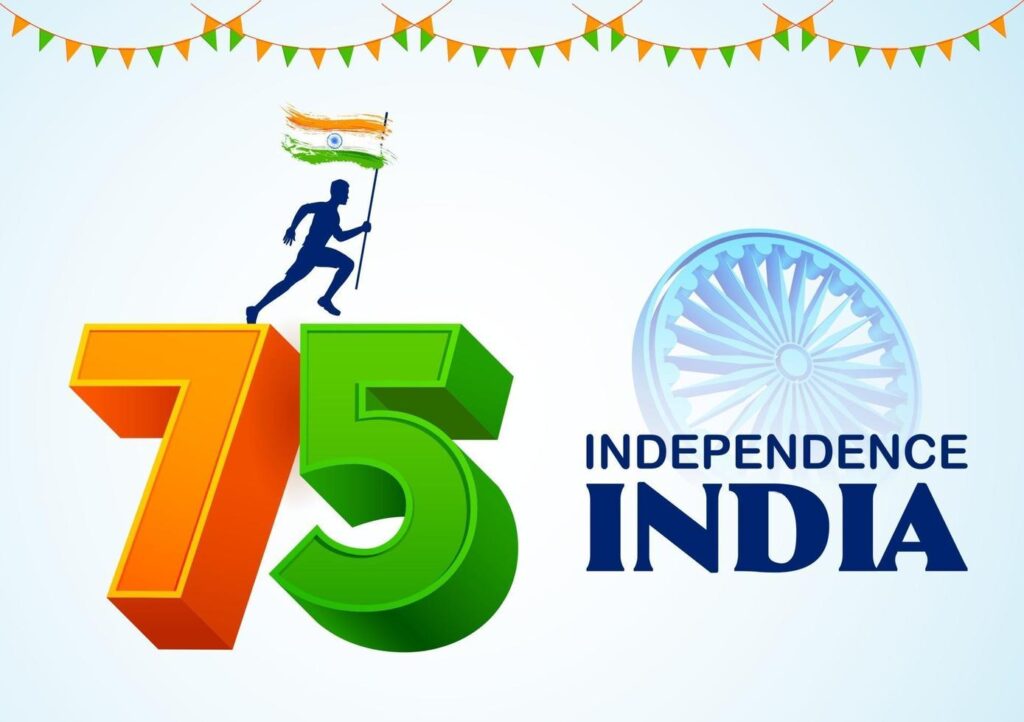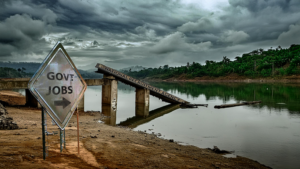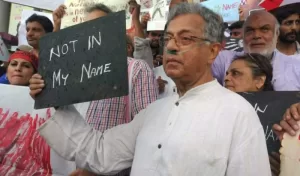On the occasion of the 75th anniversary of Independence Day, we wish our readers a Very Happy Independence Day.
Across the country, people are celebrating Independence Day this year with a week-long celebration, starting from August Kranti Diwas on August 9 (the day the Congress launched the historic Quit India movement in 1942) to August 15. While remembering and paying tributes to the heroic sacrifices made by our freedom fighters, this is also an occasion to take stock of the challenges facing our country.
The Indian subcontinent till the early 18th century was one of the world’s most developed regions. This region was the world leader in manufacturing, producing around a quarter of the world’s industrial output. The American Unitarian minister, J.T. Sunderland, writes, “India had great merchants, great businessmen, great bankers and financiers. Not only was she the greatest shipbuilding nation, but she had great commerce and trade by land and sea, which extended to all known civilised countries.” Clearly, the grounds were being laid for India’s own indigenous industrial revolution.
This thriving civilisation was destroyed by British colonial rule. They systematically went about looting India. They destroyed our vibrant industry and turned our cities into ruins. They plundered our agriculture so ruthlessly that famines ravaged the land — in a country with some of the most fertile agricultural lands in the world.
It is estimated that during the roughly 200 years of British rule, they siphoned out at least $44.6 trillion.[1] To put that sum in context, this figure is more than the combined GDP of the European Union, UK and USA!
The Indian people waged heroic struggles against British colonial rule. It was a united struggle; unlike the propaganda waged by Hindu fundamentalists today, there were no significant religious antagonisms between Hindus and Muslims then. Thus for instance, the first Indian War of Independence of 1857 began in Meerut. Over 125,000 soldiers of the Bengal army revolted, and marched to Delhi and proclaimed Bahadur Shah Zafar as the Emperor of Hindustan. What is less known is that Brahmin soldiers constituted the majority of the Bengal Army! The same declaration was made by numerous other regional potentates, both Hindu and Muslim.
During the first two decades of the 20th century, the Indian peoples’ struggle for freedom, now led by the Indian National Congress, reached new heights, especially after Gandhi took over its leadership. The Congress sought to unite the people across religious, caste, gender, regional, linguistic and cultural divisions. Gandhi’s perspective of ‘freedom’ or ‘Swaraj’ was not just freedom from colonial rule, but also freedom of the individual. For this, he evolved the weapon of ‘Satyagraha’, or non-violent struggle, a magical mantra that empowered the weakest of the weak to join the struggle. And thus did Congress succeed in building the biggest mass movement in world history to challenge the world’s biggest empire, to ultimately win freedom for India.
To weaken this united struggle, the British sought to divide the Indian people along religious lines, and for this came up with a fraudulent portrayal of history. The British ‘historian’ James Mill wrote a three volume ‘The History of India’, in which he divided the history of India into Hindu, Muslim and British periods. The first period was described as a golden period that lasted for 2000 years. During the second period of 800 years, India was under the despotic rule of Muslim kings who had subjected Hindus to immense persecution. Mill then went on to claim that (during the third, British, period) the British liberated the Hindus from this tyranny and modernised the country. It was a deliberate construct, to justify British colonialists as liberators.
British efforts to divide and weaken the Indian people’s freedom struggle got a boost with an important negative development of this period, the birth of Hindu and Muslim communal organisations. The Muslim League was formed in 1906, and the Hindu Mahasabha was formed in 1915. The Rashtriya Swayamsevak Sangh (RSS) was formed in 1925. For the Muslim League, the real enemy of the Muslims were the Hindus, while for the Hindu Mahasabha and the RSS, the real enemies of the Hindus were the Muslims. These organisations claimed that Hindus and Muslims had always been separate nations. The British communalisation of Indian history came in handy for these organisations to justify their false claims.
For the last nearly a hundred years, the RSS has sought to portray medieval India (that is, the period of the Delhi Sultanate and Mughal Empire) as a Muslim period and a period of foreign rule. It has attempted to portray Muslims as destructive barbarians and immoral degenerates. But this RSS historiography is actually nothing but a British colonial construct, manufactured by them to justify their colonisation of India and at the same time sow seeds of communal divide among the people.
The Muslim League and the Hindu Mahasabha / RSS also sought to discourage their followers from joining the freedom struggle.
The founder-leader of the RSS, K.B. Hedgewar, in 1930 asked responsible workers of the Sangh not to participate in the Salt Satyagraha launched by the Mahatma Gandhi. And in 1942, his successor M.S. Golwalkar forbade RSS volunteers from taking part in the Quit India movement. Golwalkar reminded them that fighting against the British was not a part of the RSS agenda: “We should remember that in our pledge we have talked of freedom of the country through defending religion and culture, there is no mention of departure of British from here.”[2]
Thus, by their words and deeds, the Muslim League, the Hindu Mahasabha and the RSS were only weakening the freedom struggle and thereby aiding the British colonialists.
It is the colonial divide created by the British, and deepened by communal organisations like the Muslim League, Hindu Mahasabha and RSS, that led to the partition of India in 1947.
❈ ❈
India’s freedom struggle was inspired by the values of democracy, liberty, equality, secularism and fraternity. All these values were upheld by the Congress led by Gandhi and Nehru, and so it is that these values became the fundamental pillars of our Constitution, drafted under the able stewardship of Dr. B.R. Ambedkar. It is because of these principles that our country has remained united for the past 75 years, despite our immense diversity. According to the Anthropological Society of India, Indian population comprises of more than 4000 distinct communities, marked by differences in customs, language, caste, religious beliefs, cuisine, location, and what have you!
The noted historian Rajmohan Gandhi quotes the renowned Mexican poet Octavio Paz as having said: In other parts of the world, violent wars for independence had often become breeding grounds for warlords and for militarism, coups, uprisings, and civil wars; in India, Gandhi’s principle of Satyagraha helped produce democracy.[3] Most countries of Asia and Africa that became from colonial rule in the decades following the Second World War ultimately ended up becoming dictatorships. India is one of the very few countries that has remained a democracy, more than seven decades after winning freedom.
Contrast this with the history of Pakistan, whose founding leaders led by Jinnah partitioned India on the basis of religion. Pakistan was thus founded on the principle of intolerance towards the ‘other’. It led to a further partition of the country in 1971, with East Pakistan separating from West Pakistan and renaming itself Bangladesh. Intolerance towards the ‘other’ has also led to deep divisions among the various Muslim sects in Pakistan such as Shias, Sunnis, Barelvis, and Ahmadis, and thousands of people have been killed in terrorist attacks carried out by them on each other. It also led to erosion of democracy in Pakistan, with the result that Pakistan has been ruled by military dictatorships for nearly half of the country’s 75-year history.
❈ ❈
Unfortunately, today, the Narendra Modi led Bharatiya Janata Party (BJP), the political wing of the RSS, is in power at the Centre. It is taking the country down the road traversed by Pakistan.
The RSS does not believe in any of the fundamental values of the Indian Constitution.
- It does not believe in secularism. It believes in transforming secular India into a Hindu Rashtra.
- It does not believe in equality. It believes in deepening all the traditional hierarchies of the past, including both caste divide and gender inequality, as sanctioned by the infamous law book of ancient India, the Manusmriti.
- It does not believe in liberty. It seeks to impose what it believes as the ‘true Hindu way of life’, (including food habits, dress code, Hindi language, religious practices, etc.) on the entire people of the country.
- It does not believe in democracy. It has launched a brutal offensive to silence all opposition, labelling all opponents of the regime as anti-nationals, getting a docile police force to arrest them under false charges of sedition….
- It does not even respect the various institutions of our Parliamentary democracy. It is gradually undermining the functioning of our federal structure of governance. It is not allowing the Parliament to function. It is systematically subverting the independence of all our Constitutional bodies, such as the judiciary, the Election Commission, etc. It has terrorised the media into becoming a lapdog of the ruling regime. It is seeking to subjugate the opposition parties by misusing Central investigative agencies like the ED.
And so, after coming to power at the Centre in 2014, the BJP has rapidly advanced its agenda of subverting the Indian Constitution and transforming India into a Hindu Rashtra.
❈ ❈
To what end? Are the BJP–RSS really concerned about the welfare of the Hindus?
Communal organisations, be they Hindu or Muslim, are not really concerned about their communities. The leaders of these organisations are only interested in mobilising their communities for their personal wealth and power, or for cosying up to the ‘rich and powerful’.
The British during their colonisation of India had indulged in rapacious plunder of our wealth and resources. They destroyed our flourishing civilisation, which was among the most prosperous in the world. When we finally won freedom in 1947, two centuries of colonial rule had transformed India into one of the poorest countries in the world. Who were the worst sufferers of this colonial plunder? Who were the worst victims of the famines that ravaged our land, each of which led to the death of millions of people? Obviously the Hindus, as they constituted the majority of the population. But was the Hindu Mahasabha or the RSS concerned about liberating the Hindus from the yoke of colonial plunder? No! On the contrary, they sought to weaken the struggle of the people against British rule. During the time when the freedom struggle of the Indian people reached its greatest peak, the Quit India movement of 1942, the Hindu Mahasabha and the Muslim League actually came together to form the government in Bengal, Sindh and NWFP, and collaborated with the British to suppress the movement.
After the formation of Pakistan in 1947, the successive Muslim parties and military dictatorships that have ruled Pakistan for the past 75 years have run the country solely for the benefit of the wealthiest sections of society. Wealth inequality in Pakistan is at extreme levels. The richest 10% of households own 60 percent of household wealth. Meanwhile, according to the World Bank, in 2020–21, 39.3% people lived in poverty in Pakistan using the lower middle-income poverty rate of US$3.2 per day; this figure goes up to an astounding 78.4% using the upper middle-income poverty rate of US$5.5 per day.
In India too, the BJP–RSS, after coming to power in 2014, have run the country solely for the profiteering of the biggest Indian corporations, the Adanis–Ambanis and others of their ilk. Consequently, the wealth of the country’s billionaires has zoomed during the Modi years: over the period 2014 to 2021, the total number of dollar billionaires in the country has gone up from 56 to 142, and their combined wealth has more than tripled over this period, from $192 bn to $719 bn.[4] This latter figure is more than one-fifth of India’s GDP (22.7%) for the year 2021!
While the rich are rolling in wealth, thanks to Modi largesse, the ordinary people are facing the highest ever unemployment, malnutrition and poverty levels in nearly five decades. To give just one example: for the first time in the past 50 years, the absolute number of poor has increased during the Modi years: from 27 crore in 2011–12 to 34.6 crore in 2019–20.[5] The Modi Government’s inept and apathetic handling of the corona pandemic has further worsened this crisis: it is estimated that 23 crore people were pushed into poverty in the first year of the pandemic (2020).[6]
The people and the opposition parties have been protesting against this naked pro-corporate anti-people agenda being implemented by the BJP. And so, the BJP on the one hand is trying to subjugate the opposition parties and attack the right to dissent guaranteed by the Constitution and crush people’s protests. And on the other hand, the RSS and its innumerable wings are seeking to divert the attention of the people by deepening the communal divide. They are trying to instill fear among the majority (80% of the people by its definition), that they are in danger from the minority communities, especially the Muslims and Christians. All kinds of malicious hate campaigns are being launched, targeting the minorities. In this country of Kabir, Nanak and Tukaram, which was renowned the world over for its syncretic culture, the RSS has succeeded in spreading so much poison that Muslims are even being lynched today.
Actually, the RSS is doing nothing new. It is only doing what it has done for the past hundred years. During the freedom struggle, it sought to spread communal hatred and divide the people to divert their attention from colonial plunder. Today, it is doing so to divert the attention of the people from corporate plunder.
❈ ❈
With the fundamental pillars of the Constitution — democracy and secularism — being undermined, with the BJP–RSS seeking to subvert the Constitution itself, while at the same time running the economy for naked corporate profiteering, the country is clearly facing its most difficult time since independence.
For progressives and socialists, when democracy itself is under threat, the first task is to defend democracy. Let us keep aside our petty organisational interests, join hands with all anti-BJP–RSS organisations and political parties, and unitedly fight the BJP–RSS combine. While doing so, it is of utmost importance to reach out to the ordinary people, a large number of whom are under the influence of the vicious communal propaganda launched by not just the RSS but also communal Muslim organisations, explain to them the real nature of the ruling regime at the Centre, and the real solutions to the unemployment–poverty–inflation crisis gripping the country. While seeking to build such a united front, we must of course try and influence the leading opposition parties to adopt a more pro-people socialist economic agenda as outlined in the Directive Principles of the Constitution.
On the 75th anniversary of our country’s independence, let us dedicate ourselves to defending the spirit of our freedom fighters, whose dreams for the future of our country are embodied in the Constitution.
Notes
1. “British Raj Siphoned Out $45 trillion from India: Utsa Patnaik”, Janata Weekly, January 6, 2019.
2. See: “History Shows How Patriotic the RSS Really Is”, The Wire, 7 October 2018, https://thewire.in; Ram Puniyani, “Gandhi’s Wariness of RSS’ Ideology Is Clear from His Writings, Historical Record”, 18 April 2019, https://indianexpress.com.
3. Cited in Rajmohan Gandhi, Why Gandhi Still Matters, Aleph Book Company, 2017, p. 17.
4. “Global Billionaire Wealth Scales New Heights; India Disappoints”, 4 March 2014, https://economictimes.indiatimes.com; “Wealth Of India’s 10 Richest Enough to Fund Higher Education of Every Child: Oxfam”, 17 January 2022, https://www.outlookindia.com.
5. Santosh Mehrotra and Jajati Keshari Parida, “‘Pakoda’ Employment Has Increased Poverty Over the Last Eight Years”, https://thewire.in.
6. “230 Million Indians Pushed into Poverty Amid Covid-19 Pandemic: Report”, 6 May 2021, https://www.business-standard.com.




